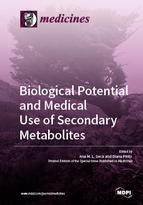Biological Potential and Medical Use of Secondary Metabolites
A special issue of Medicines (ISSN 2305-6320).
Deadline for manuscript submissions: closed (28 February 2019) | Viewed by 114627
Special Issue Editors
Interests: bioactive natural compounds; secondary metabolites; chromatographic techniques; spectroscopic techniques; natural compounds
Special Issues, Collections and Topics in MDPI journals
Interests: organic chemistry; medicinal chemistry; biotransformations; natural products; plant chemical profile; sustainable chemistry
Special Issues, Collections and Topics in MDPI journals
Special Issue Information
Dear Colleagues,
Many macro and micro species, from terrestrial and aquatic environments, produce structurally unique compounds and, in many countries, still are the primary sources of medicines. In fact, secondary metabolites are an important source of chemotherapeutic agents, but are also lead compounds for synthetic modification and optimization of biological activity. Therefore, the exploitation of secondary metabolites, or their inspired synthetic compounds, offers excellent opportunities for the pharmaceutical industry.
This Special Issue of Medicines aims to compile both original articles and reviews, covering the most recent advances on the phytochemistry, biological activities, and action mechanisms of secondary metabolites from plants, macroalgae and microorganisms. In vitro studies will be welcome, only if molecular mechanisms are well defined. In vivo studies and clinical trials or preclinical studies are not only included in the scope, but are encouraged.
As Guest Editors of this Special Issue of Medicines, we invite you to provide original research contributions, as well as review articles, related to biological activities and medicinal uses of secondary metabolites.
We look forward to receiving your contributions to this Special Issue.
Prof. Dr. Ana M. L. Seca
Dr. Diana Cláudia Pinto
Guest Editors
Manuscript Submission Information
Manuscripts should be submitted online at www.mdpi.com by registering and logging in to this website. Once you are registered, click here to go to the submission form. Manuscripts can be submitted until the deadline. All submissions that pass pre-check are peer-reviewed. Accepted papers will be published continuously in the journal (as soon as accepted) and will be listed together on the special issue website. Research articles, review articles as well as short communications are invited. For planned papers, a title and short abstract (about 100 words) can be sent to the Editorial Office for announcement on this website.
Submitted manuscripts should not have been published previously, nor be under consideration for publication elsewhere (except conference proceedings papers). All manuscripts are thoroughly refereed through a single-blind peer-review process. A guide for authors and other relevant information for submission of manuscripts is available on the Instructions for Authors page. Medicines is an international peer-reviewed open access monthly journal published by MDPI.
Please visit the Instructions for Authors page before submitting a manuscript. The Article Processing Charge (APC) for publication in this open access journal is 1400 CHF (Swiss Francs). Submitted papers should be well formatted and use good English. Authors may use MDPI's English editing service prior to publication or during author revisions.
Keywords
- secondary metabolites
- bioactive compounds
- phytochemistry
- biological activities
- in vitro and in vivo studies
- clinical trials






